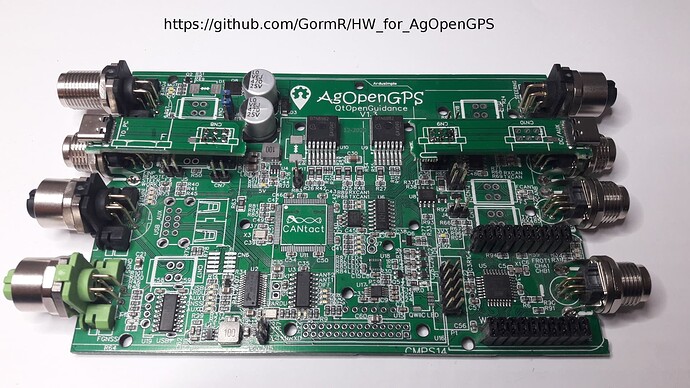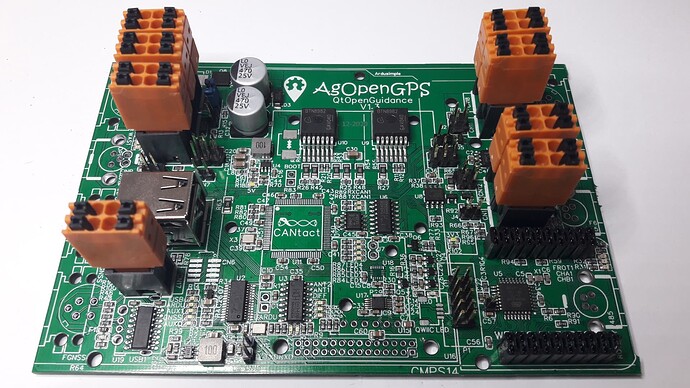PCBAs have arrived in Frankfurt; waiting for customs… I’ll keep you tuned!
No connectors is not a big deal at all.
But removing 90% of the soldering time is awesome. Being more compact is exciting.
Very interested how the first ones turn out!
Full featured M12/M8 PCBA
Full features PushIn PCBA

Autosteer PushIn PCBA

Soldering is no rocket science (but the 2 USB-C in the first picture took half an hour of my life ![]() )
)
Quick update with the first pictures. Already tested and working:
- power supplies
- USB hub
- Nano bootloader programming
Known issues till now:
- Some extra milling at the edge necessary if using M8 connectors
can’t wait to see the result, great job! ![]()

Modbus is working, so Modbus relay modules can be controlled via RS485!
Python code of this example:
import minimalmodbus
import serial
#assign RS-485 interface to serial port (use “COM…” for Windows, “/dev/ttyUSB…” for Linux)
AOG_Modbus = minimalmodbus.Instrument(“/dev/ttyUSB1”, 1)
AOG_Modbus.serial.baudrate = 9600
Relay = 5
State = 0x0100 # possibilities: 0x0100 = on, 0x0200 = off, etc
status = AOG_Modbus.write_register(Relay, State, 0, 6, False)
Nice! those 485 output modules are all pre maid and cheap like borscht on Aliexpress. Can’t get much easier output setup than that! Also 485 can go a very long distance.
Very Nice boards you have created.
Great work!
Made a small video about setting up the board (the first one I ever made!). There is also a German version.
I also added some pictures to my github folder (“documents”).
Will add more information in the next time there.
Tested yet:
- USB hub
- Atmel section with I/Os needed for AOG
- power supply
- motor driver
- WAS input
- RS485 / Modbus
Still untested:
- CAN
- ESP32 option
- Bynav option
@GoRoNb Nice PCB, there is a relay for 6/2 valve if you run hydraulic control?
there is enough cooling on ibt2 if you use electric motor?
There is a general propose 12V output you may use for anything:

The coil of the relay can be connected between the output and +Battery.
I never worked with hydraulics; do you have a link for me? I’ll double-check…
The motor driver has an on-resistance of about 7mOhm. Assuming 5A of average current, we have 175mW + some switching losses for each of the two drivers. Should be no prob even in summertime.
Look at steer.png in AOG support files, (dir1 / D4) the blue arrow care you put a small relay on to pull 6/2 valve, when it is pulled the steering wheel can not be used, will not be optimal with your suggestion
Not 100% sure, but if you only need the digital signal DIR1/D9, you can connect to the highlighted pin in the middle of the picture next to the text “R59”:


Uuups, testing dual-CAN will take a while ![]()
I’ve to correct my answer; the Cytron in the steer.png confused me…
I’m using a circuit like the IBT-2, so the DIR1_RL_ENABLE = D4 is the signal to control the 6/2 valve. It can be found here (underneath the yellow “D1” text):

I also found an “old” link discussing the same topic: Hydraulic valve info from Telegram group - #90 by Richardklasens_admin
There is another option I would prefer: Just add two lines of code, copying the D4 bit to the D5 bit and use the signal available at the “Steering” connector:

@GoRoNb I wrote wrong, you are right it is D4 we use to activate a small relay for 6/2 valve when we are in IBT2 mode, can not fit this relay on your PCB?
Agree, nice idea to add it although hydraulic steering is critical in Europe… But no relay; that’s old style. Protected MOSFETs like BTS5030-1EJA are the smarter and more reliable choice.
@GoRoNb I do not have a grand sense of electronics components, hope you find room for it, believe there is a part that uses hydraulics.
Yes, there was some space left to add this function via U14:

For assembling this part, edit the BOM file (“xU14” => “U14”, delete “R59”)
The 6/2 output will be on this track:

Furthermore you can put a solder joint on the bottom and remove “R76” + “F7” to make “SERVO+” to “-MOTOR” (= “-Battery” via emergency stop button), so that all signals to the valves are on “CN18”. That avoids current loops and you have a failsafe switching via the positively opening stop botton.

Looks great! Nice video, can’t believe it’s the first one. I love the small design and enclosure. Still can’t believe its cheaper than ordering all the parts and soldering yourself. I am going to try to place an order. Great job!
I think for most farmers just trying to get it to steer this is 100% hands down the way to go.
The only thing I can see changing just for the fun of tinkering is having a socket where the nano chip is to accept a teensy4.0, or I guess I could learn ESP.
Hopefully V4+ is still compatible it sounds like quite the revision in the works.
But very good job this is very excellent work, I wish I had the skills to build hardware like this.

